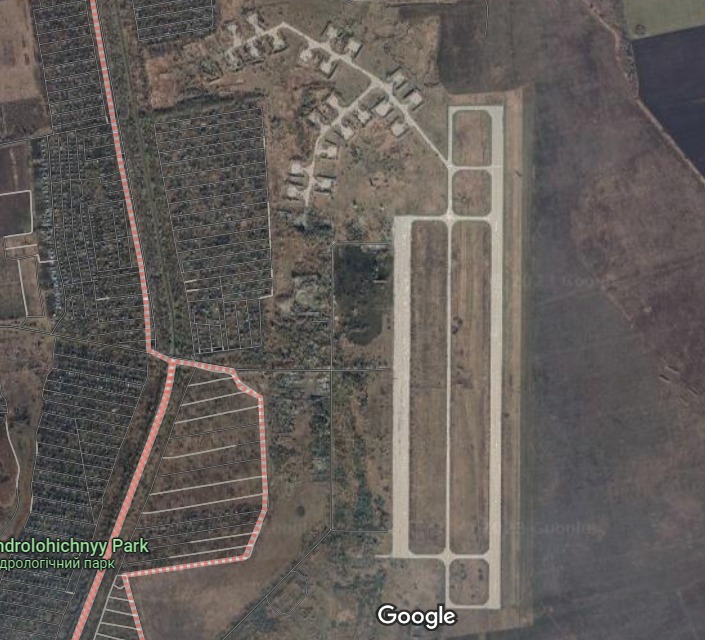According to the Ukrainian Air Force, “On the night of September 11, 2023, Russia attacked Ukraine with 12 Geran-2 kamikaze drones from the southeast (Yeysk, Primorsko-Akhtarsk – Russian Federation).
“Also, Russia used tactical aviation in the Dnipropetrovsk region, launching Kh-31P anti-radar missiles and Kh-59 guided air missiles from Su-34/Su-35 aircraft.”
Several telegram channels are reporting that the main target of the Russian attack was the Dolgintsevo airfield on the outskirts of Kirvoy Rog, in the Dnipropetrovsk region, where several aircraft of Ukrainian military aviation were present.
It’s claimed that two MiG-29 fighters and three Su-25 attack aircraft of the Ukrainian Air Force were destroyed on the airfield, and elements of the airfield infrastructure were also damaged.
Local officials confirmed the attack on the airbase.
“Krivoy Rog Explosions. Do not film anything and do not post videos on the Internet,” the head of the military administration, Alexander Vilkul, wrote in the telegram channel.
Dolgintsevo Airbase, Krivoy Rog
No Ukrainian military aircraft are permanently located at Dolgintsevo airbase near Krivoy Rog city in south-central Ukraine. The base is routinely used to launch drone strikes on Crimea using Chinese Mugin-5 PRO UAVs repurposed for kamikaze attacks.

In 2017, the Soviet-era base, which used to host Il-76 freighters, was restored to support operations by all types of aircraft in service with the Ukrainian Air Force.
Google Maps satellite photo of the airbase shows no hardened shelters, which would imply that there is no long-term parking of military aircraft at the base.
Dolgintsevo Airbase Strike
According to a Russian military expert, Ukrainian military aircraft have been observed operating from Dolgintsevo since the beginning of September. Also, a batch of HARM missiles and drones was delivered to the airbase to attack Russian rear areas. The Russian Aerospace Forces were able to get ahead of the enemy.
Local reports indicate that the Russian attack took place in two waves. If the reports are correct, it is likely that the first wave comprised Geran-2 drones sent to ‘light up’ Ukrainian air defense radars around the airfield and attack them with Kh-31P anti-radiation missiles.
In which case, the Ukrainian Air Force claims that it shot down all the Geran-2 kamikaze drones launched by Russia may well be ironic because the Geran-2 drones shot down would have achieved their purpose by being shot down.
Russian Intelligence Success
The alleged destruction of Ukrainian fighters at Dolgintsevo air base may well be another stellar success of Russian humanist (Human Intelligence).
As mentioned earlier, the base has no hardened shelters. Therefore, it is likely that the base is used for staging attacks launched from bases deeper in the interior and Western Ukraine.
The attacking aircraft land at Dolgintsevo, most likely only to refuel. An additional advantage is that when they get airborne to attack, because of the proximity of the airbase to the front line, the warning time available to Russian air defense is reduced.
The fact that Russian forces were able to launch missile attacks on Dolgintsevo air base while the Ukrainian Air Force fighters were staging through could only have been achieved through humanint.
The Russians not only knew when the aircraft arrived at the base, they knew the precise location at which they were parked. It’s highly unlikely that Russian forces could have obtained targetting information using space or air-based ISR assets.
Past Humanint Successes
To conserve its missile inventory, Russia has been increasingly relying on precise, timely, actionable humanint from its resources in Ukrainian occupied territory.
Russia’s interdiction campaign in Russian-speaking regions of Ukraine-occupied territory has yielded outstanding results. Russia has repeatedly and successfully struck trains unloading ammunition, staging areas of troop reserves being moved to the battlefront, and command and control centers where meetings were underway.
Russian precision attacks in the Odessa port region, once again based exclusively on humanint, have disrupted weapon and ammunition supplies from US and NATO nations.
The fact that Ukraine has not been able to launch Storm Shadow / Scalp cruise missile attacks for over a month now is testimony to both excellent Russian humanint, as well as the accuracy of Russian precision strike weapons.
In the past, the US and NATO have been derisive about the capabilities of Russian precision strike weapons. They are now paying a heavy price for their delusions.

Kh-59
The Russian Kh-59 air-launched cruise missile appears to be playing an important role in Russia’s interdiction campaign. The Kh-59, which features a 360-kg lethality package, is designed to penetrate static hardened and buried targets.
There are different variants of the missile featuring TV, Active Radar, or Optical seekers. The Kh-59MKM variant with the optical seeker is a fire-and-forget missile that can accurately navigate in starlight conditions. It has a CEP in the range of 3-5 m.
Conclusion
Russia appears to have completely switched to well-planned small missile and drone strikes based on actionable humanint.
The limited use by Ukraine of US / NATO long-range precision strike weapons such as HIMARS, Storm Shadow, Scalp, JDAM, and HARM hints at stock limitations, which in turn vouches for the efficacy of the Russian interdiction campaign.
Under these circumstances, the infusion of new long-range Western weapons, such as the West German Taurus missile and the US ATACMS, will likely make little difference to the course of the war.
- Vijainder K Thakur is a retired IAF Jaguar pilot. He is also an author, software architect, entrepreneur, and military analyst. VIEWS PERSONAL
- Follow the author @vkthakur




